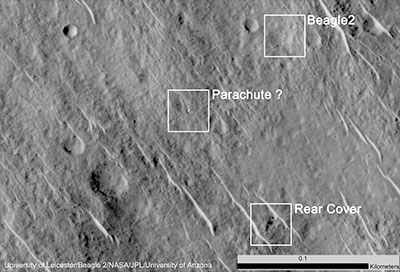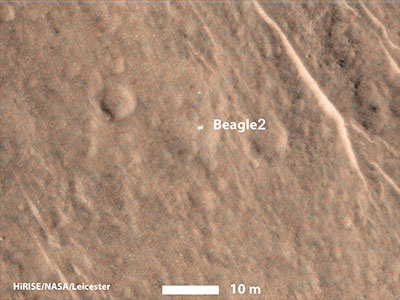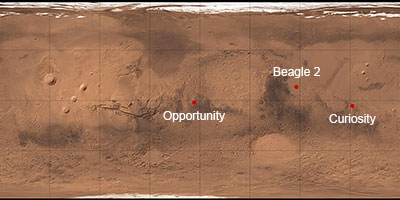|
|

|
|
Author
|
Topic: UK-led Beagle 2 lander found intact on Mars
|
Robert Pearlman
Editor Posts: 42988
From: Houston, TX
Registered: Nov 1999
|
 posted 01-16-2015 08:17 AM
posted 01-16-2015 08:17 AM
   
UK Space Agency release UK-led Beagle 2 lander found on MarsThe UK-led Beagle 2 Mars Lander, thought lost on Mars since 2003, has been found partially deployed on the surface of the planet, ending the mystery of what happened to the mission more than a decade ago. This find shows that the Entry, Descent and Landing (EDL) sequence for Beagle 2 worked and the lander did successfully touchdown on Mars on Christmas Day 2003. Beagle 2 hitched a ride to Mars on ESA's Mars Express mission and was a collaboration between industry and academia. It would have delivered world-class science from the surface of the Red Planet. Many UK academic groups and industrial companies contributed to Beagle 2. Images taken by the HiRISE camera on NASA's Mars Reconnaissance Orbiter (MRO) and initially searched by Michael Croon of Trier, Germany, a former member of ESA's Mars Express operations team at ESOC, have identified clear evidence for the lander and convincing evidence for key entry and descent components on the surface of Mars within the expected landing area of Isidis Planitia (an impact basin close to the equator). Since the loss of Beagle 2 following its landing on Christmas Day 2003, Michael has, in parallel with members of the Beagle 2 industrial and scientific teams, been patiently screening images from HiRISE looking for signs of Beagle 2. Subsequent re-imaging and analysis by the Beagle 2 team, HiRISE team and NASA's Jet Propulsion Laboratory (JPL) has confirmed that the targets discovered, are of the correct size, shape, colour and dispersion (i.e. separation) to be Beagle 2. "The history of space exploration is marked by both success and failure," Dr. David Parker, Chief Executive of the UK Space Agency, said. "This finding makes the case that Beagle 2 was more of a success than we previously knew and undoubtedly an important step in Europe's continuing exploration of Mars." The images, following analysis by members of the Beagle 2 team and NASA, show the Beagle 2 lander in what appears to be a partially deployed configuration, with what is thought to be the rear cover with its pilot/drogue chute (still attached) and main parachute close by. Due to the small size of Beagle 2 (less than 2m across for the deployed lander) it is right at the limit of detection of imaging systems (cameras) orbiting Mars. The targets are within the expected landing area at a distance of about 5km from its centre. Several interpretations of the image of the lander have been identified, consistent with the lander's size and shape. The imaging data is however consistent with only a partial deployment following landing. This would explain why no signal or data was received from the lander — as full deployment of all solar panels was needed to expose the RF antenna which would transmit data and receive commands from Earth. "I am delighted that Beagle 2 has finally been found on Mars," said University of Leicester professor Mark Sims, who was an integral part of the Beagle 2 project from the start leading the initial study phase and was Beagle 2 Mission Manager and led the Flight Operations team. "Every Christmas Day since 2003 I have wondered what happened to Beagle 2. My Christmas day in 2003 alongside many others who worked on Beagle 2 was ruined by the disappointment of not receiving data from the surface of Mars. To be frank I had all but given up hope of ever knowing what happened to Beagle 2." "The images show that we came so close to achieving the goal of science on Mars," Sims continued. "The images vindicate the hard work put in by many people and companies both here in the UK and around Europe and the world in building Beagle 2. The highly complex entry, descent and landing sequence seems to have worked perfectly and only during the final phases of deployment did Beagle 2 unfortunately run into problems." "I view it as a great achievement that the team built Beagle 2 in a little over four years and successfully landed it on the surface of Mars. It was a great pity we couldn't have delivered the world class science Beagle 2 may have brought and even sadder that Colin [Pillinger] and other colleagues who died in 2014 didn't live to see the discovery that Beagle 2 made it to Mars," he concluded. "Beagle 2 showed the fantastic innovation skills available from UK academia and industry and inspired many people in particular the young. Many opportunities exist for the UK, working with other countries to do inspired space exploration and science (subject of course to available funding)." Unfortunately given the partial deployment (and covering of the RF antenna) it would not be possible to revive Beagle 2 and recover data from it. Professor Colin Pillinger from the Open University who led the Beagle 2 project with inspirational enthusiasm died in May 2014. Others that provided major contributions to Beagle 2 were Professor George Fraser of the University of Leicester and Professor David Barnes of Aberystwyth University who also died in 2014. |
Robert Pearlman
Editor Posts: 42988
From: Houston, TX
Registered: Nov 1999
|
 posted 01-16-2015 08:17 AM
posted 01-16-2015 08:17 AM
   
NASA Jet Propulsion Laboratory release 'Lost' 2003 Mars Lander Found by Mars Reconnaissance OrbiterThe Beagle 2 Mars Lander, built by the United Kingdom, has been thought lost on Mars since 2003, but has now been found in images from NASA's Mars Reconnaissance Orbiter. A set of three observations with the orbiter's High Resolution Imaging Science Experiment (HiRISE) camera shows Beagle 2 partially deployed on the surface of the planet, ending the mystery of what happened to the mission more than a decade ago. They show that the lander survived its Dec. 25, 2003, touchdown enough to at least partially deploy its solar arrays.  Beagle 2 hitched a ride to Mars on the European Space Agency's long-lived Mars Express mission. It was a collaboration between industry and academia designed to deliver world-class science from the surface of the Red Planet. "I am delighted that Beagle 2 has finally been found on Mars," said Mark Sims of the University of Leicester, U.K. He was an integral part of the Beagle 2 project from the start, leading the initial study phase and was Beagle 2 mission manager. "Every Christmas Day since 2003 I have wondered what happened to Beagle 2. My Christmas Day in 2003 alongside many others who worked on Beagle 2 was ruined by the disappointment of not receiving data from the surface of Mars. To be frank I had all but given up hope of ever knowing what happened to Beagle 2. The images show that we came so close to achieving the goal of science on Mars. HiRISE images initially searched by Michael Croon of Trier, Germany, a former member of the European Space Agency's Mars Express operations team, provide evidence for the lander and key descent components on the surface of Mars within the expected landing area of Isidis Planitia, an impact basin close to the equator.  Subsequent re-imaging and analysis by the Beagle 2 team, the HiRISE team and NASA's Jet Propulsion Laboratory, Pasadena, California, have confirmed that the targets discovered are of the correct size, shape, color and dispersion to be Beagle 2. JPL planetary geologist Tim Parker, who has assisted in the search and processed some of the images said, "I've been looking over the objects in the images carefully, and I'm convinced that these are Beagle 2 hardware." Analysis of the images indicates what appears to be a partially deployed configuration, with what is thought to be the rear cover with its pilot/drogue chute (still attached) and main parachute close by. Due to the small size of Beagle 2 (less than 7 feet, or 2 meters across for the deployed lander) it is right at the limit of detection of HiRISE, the highest-resolution camera orbiting Mars. The targets are within the expected landing area at a distance of about three miles (five kilometers) from its center. "I can imagine the sense of closure that the Beagle 2 team must feel," said Richard Zurek of JPL, project scientist now for Mars Reconnaissance Orbiter (MRO) and previously for NASA's still-missing 1998 Mars Polar Lander. "MRO has helped find safe landing sites on Mars for the Curiosity and Phoenix missions and has searched for missing craft to learn what may have gone wrong. It's an extremely difficult task, as the craft are small and the search areas are vast. It takes the best camera we have in Mars orbit and work by dedicated individuals to be successful at this." HiRISE is operated by the University of Arizona, Tucson. The instrument was built by Ball Aerospace & Technologies Corp. of Boulder, Colorado. The Mars Reconnaissance Orbiter Project is managed for NASA's Science Mission Directorate in Washington, by JPL, a division of the California Institute of Technology, Pasadena. |
Blackarrow
Member Posts: 3120
From: Belfast, United Kingdom
Registered: Feb 2002
|
 posted 01-16-2015 08:20 AM
posted 01-16-2015 08:20 AM
  
It would have meant a lot to Colin Pillinger, the moving force behind the project, to know that his brainchild did, after all, make it to the surface of the red planet. Sadly, Colin died last year. It seems, to adapt the words of Rupert Brooke, that "...there's some corner of a Martian plain that is forever England." |
Kite
Member Posts: 831
From: Northampton UK
Registered: Nov 2009
|
 posted 01-16-2015 08:20 AM
posted 01-16-2015 08:20 AM
  
I think that is wonderful news and what a shame Colin didn't live long enough to know. Some of the media tended to deride his efforts but we all know just how difficult this type of exploration is, particularly on Mars. |
One Big Monkey
Member Posts: 169
From: West Yorkshire, UK
Registered: Jul 2012
|
 posted 01-16-2015 08:20 AM
posted 01-16-2015 08:20 AM
  
I have to agree - it is such a pity that he didn't get to see it and maybe have some questions answered. |
Kite
Member Posts: 831
From: Northampton UK
Registered: Nov 2009
|
 posted 01-16-2015 08:20 AM
posted 01-16-2015 08:20 AM
  
It is reported that Beagle had landed intact within five kilometres of its intended location and not crashed. It appears that perhaps its petals did not expand properly and so were still covering the communications facilities. So near yet so far from success. What a great shame for Colin Pillinger and his team. |
Glint
Member Posts: 1040
From: New Windsor, Maryland USA
Registered: Jan 2004
|
 posted 01-16-2015 10:38 AM
posted 01-16-2015 10:38 AM
   
Now if they could only discover what happened to the Mars Observer... |
dabolton
Member Posts: 419
From: Seneca, IL, US
Registered: Jan 2009
|
 posted 01-16-2015 10:52 AM
posted 01-16-2015 10:52 AM
  
If they could get the petals deployed, could the solar cells recharge the batteries enough to awaken? |
Robert Pearlman
Editor Posts: 42988
From: Houston, TX
Registered: Nov 1999
|
 posted 01-16-2015 10:55 AM
posted 01-16-2015 10:55 AM
   
With even one petal folded, there is no way to communicate with the lander to deploy the remaining petal(s). |
dabolton
Member Posts: 419
From: Seneca, IL, US
Registered: Jan 2009
|
 posted 01-16-2015 11:04 AM
posted 01-16-2015 11:04 AM
  
How far is the nearest of our still-operational rovers? |
Robert Pearlman
Editor Posts: 42988
From: Houston, TX
Registered: Nov 1999
|
 posted 01-16-2015 12:59 PM
posted 01-16-2015 12:59 PM
   
Too far away... Curiosity, the closer of the two, is never expected to leave Gale Crater.  |
Glint
Member Posts: 1040
From: New Windsor, Maryland USA
Registered: Jan 2004
|
 posted 01-16-2015 12:59 PM
posted 01-16-2015 12:59 PM
   
quote:
Originally posted by Kite:
It appears that perhaps its petals did not expand properly...
Great news for humanity, but perhaps not so great for some. If I was on the team responsible for building the control mechanism for unfolding the petals, I'd be cringing about now. It would perhaps be better for them if we had never learned the truth. |
Robert Pearlman
Editor Posts: 42988
From: Houston, TX
Registered: Nov 1999
|
 posted 01-16-2015 01:05 PM
posted 01-16-2015 01:05 PM
   
That's assuming it was a mechanical failure that prevented the petal(s) from deploying. The HiRISE team isn't even entirely sure of how many of the petals unfolded. The HiRISE images reveal only two or three of the motorized solar panels, but that may be due to their favorable tilts for sun glints. Further imaging and analysis is planned to narrow down the options for what happened. |
Glint
Member Posts: 1040
From: New Windsor, Maryland USA
Registered: Jan 2004
|
 posted 01-16-2015 01:24 PM
posted 01-16-2015 01:24 PM
   
quote:
Originally posted by Robert Pearlman:
That's assuming it was a mechanical failure that prevented the petal(s) from deploying.
In that case, I will rephrase the earlier comment, from a strictly engineering point of view, and say: Woe to them on whom, based on the new evidence and the inevitably renewed root cause investigation, the blame shall fall heavy as a millstone about the neck!On the other hand, some others, who may have previously been under suspicion, may find themselves exonerated by the news. |
Robert Pearlman
Editor Posts: 42988
From: Houston, TX
Registered: Nov 1999
|
 posted 01-16-2015 01:31 PM
posted 01-16-2015 01:31 PM
   
Hah! But you raise an interesting question: will this trigger a new (formal) root cause investigation (beyond the HiRISE continued observations)? The Beagle 2 team has disbanded and, sadly, a number of key leaders have since died. The proposal for a Beagle 3 was rejected in 2004. It will be interesting to see where this leads... |
Blackarrow
Member Posts: 3120
From: Belfast, United Kingdom
Registered: Feb 2002
|
 posted 01-16-2015 03:12 PM
posted 01-16-2015 03:12 PM
  
Elon Musk would probably say "Close, but no cigar." The evidence does seem to suggest that the landing procedures worked, at least well enough to deliver the payload to the surface of Mars intact. I think the team that built Beagle are entitled to feel happy, but frustrated. So close....One further point: would it be unreasonable to ask the International Astronomical Union to name that part of Isidis Planitia where Beagle 2 landed "Pillinger Regio"? |
SpaceAholic
Member Posts: 4437
From: Sierra Vista, Arizona
Registered: Nov 1999
|
 posted 04-28-2016 11:42 AM
posted 04-28-2016 11:42 AM
   
Improved/enhanced images of Beagle 2. Scientists "stacked and matched" photos captured over the years by NASA's eagle-eyed Mars Reconnaissance Orbiter (MRO) using new machine-vision methods, creating images in which features just 2 inches (5 centimeters) wide can be seen.This resolution is five times greater than MRO or any other instrument orbiting Earth or Mars had been able to achieve, researchers said. | |
Contact Us | The Source for Space History & Artifacts
Copyright 2020 collectSPACE.com All rights reserved.

Ultimate Bulletin Board 5.47a
|
|

|
 advertisement advertisement

|














